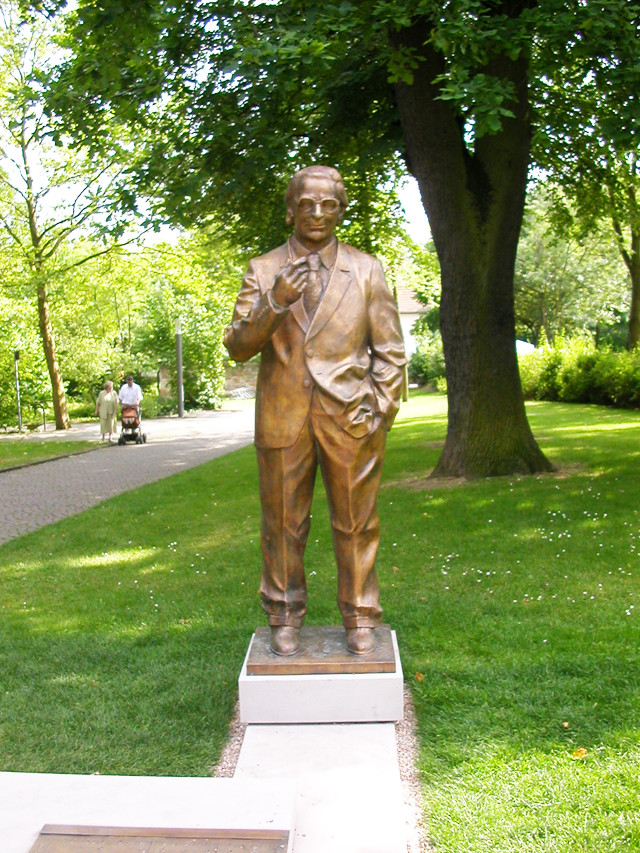
by Jacob Haqq-Misra Friday, October 27, 2017

Statue of Konrad Zuse, Bad Hersfeld, Germany. Credit: Profiler 1888, CC BY-SA 3.0.
German engineer Konrad Zuse is considered the first inventor of the programmable electronic computer in his home country, but sadly, few students elsewhere learn of his pioneering efforts. Zuse’s legacy extends beyond his groundbreaking circuit designs, also encompassing advances in computational theory and even philosophical musings about the computational nature of the universe.
Zuse was an inventive child with talents for painting and architecture. These interests led him to study civil engineering at the Technical University of Berlin, from which he graduated in 1935. During his engineering studies and a brief sojourn into the working world, he learned the monotony of performing the mathematical calculations required to determine the ideal construction of aircraft, buildings and other structures. So, he began tinkering with ways to automate the process, soon devoting himself full-time to designing an efficient calculating machine.
By 1938, he had completed the design of the Z1, a fully programmable computing machine. Built in his parents’ apartment with assistance from friends and occasional small donations — an early example of crowdfunding — the Z1 used mechanical plates to store data using the binary system. It was a design of Zuse’s own creation that bore little resemblance to the calculator technology being developed elsewhere.
Drafted into service during World War II, Zuse convinced his superiors to allow him to continue his research. He eventually found a way to develop machines that would aid in the aerodynamic construction of “flying bombs” (akin to cruise missiles today). He also channeled this effort into a new general-purpose machine, the Z2, which used a processor built from electronic relays but still depended on mechanical memory storage. The Z2 was impressive enough to the German Airspace Research Office that the agency partially financed Zuse to build its successor.
The Z3 began operating in 1941; it was Zuse’s first fully electronic computing machine that used only relays for both processing and memory, and indeed, the first such machine anywhere in the world. It would be another five years until the general-purpose ENIAC computer was dedicated at the University of Pennsylvania.
Following the war, Zuse began producing a line of computers under his company banner “Zuse KG.” He also developed a programming language known as Plankalkül (translated as “plan calculus”), considered to be among the first high-level programming languages. Zuse KG initially flourished, but by the 1960s, American corporations were dominating the computer market in Europe. In 1962, Zuse KG was acquired and by 1971, its assets were liquidated and the Zuse line of computers was discontinued.
Zuse’s original approach to computer design is inextricably linked with the mathematical concept of finite state machines, or finite automata. Finite state machines can exist in just one state at any time, with calculations performed when the machine transitions to a new state upon receiving an external input. An elevator, for example, can be described as such a machine: It can be located only at one position — “one state” — in its shaft at a time, and it can only move (" transition between states") when prompted by an operator pushing a button. Zuse’s later, more sophisticated computer designs depended upon equally ambitious advances in the mathematics of finite state machines to which he contributed. The influences of his ideas on finite state machines permeate modern computer science texts, although his name and writings often remain unmentioned.
The most grandiose of Zuse’s ideas were expounded upon in his 1969 book “Rechnender Raum,” usually translated as “Calculating Space.” Zuse meticulously argues that the discrete architecture of the finite state machine suggests digital theories of basic physics. Zuse conjectures that, rather than the wave-like or point-like analogies of conventional physics, fundamental particles like electrons could be conceived of in terms of a digital model, which would suggest that the motion and behavior of subatomic particles could — in a grand, abstract sense — be considered as the realization of a calculation. Extending this logic, Zuse surmised that the universe itself might be an enormous finite state machine, with unfathomable computational power. Few physicists seriously pursue Zuse’s models of digital physics, although his models remain plausible even within the scope of modern quantum physics and cosmology.
Konrad Zuse’s achievements were overshadowed by the rapid growth of American computing, fueled by the Allied victory. Yet Zuse remains a pivotal figure in the history of computer science, as one of the pioneers of both hardware and software design. His philosophical musings have also inspired continued thinking about digital physics. Zuse imagined a mechanized and interconnected system that includes every particle, planet and person as part of its machinery, all working together in harmony. Zuse’s universe lives on, if only poetically, and deserves to be celebrated.
© 2008-2021. All rights reserved. Any copying, redistribution or retransmission of any of the contents of this service without the expressed written permission of the American Geosciences Institute is expressly prohibited. Click here for all copyright requests.